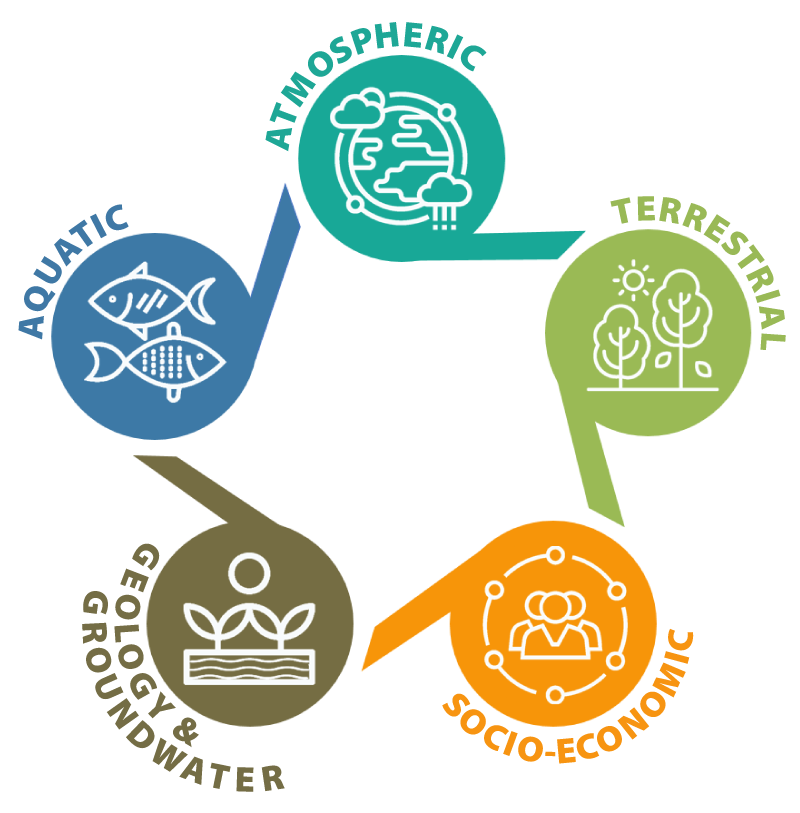Canadian Nuclear Laboratories is committed to the safety of the public, its workers and the environment while undertaking this community-requested solution to a longstanding environmental issue.
CNL conducts ongoing environmental monitoring to protect human health and the environment and ensure effects from construction and waste excavation activities are minimized. It provides assurance that human health and the environment are being protected, as the environmental assessment predicted, and reveals if further actions are needed to reduce project effects.


Atmospheric Environment
CNL monitors both air quality at all work sites and the near vicinity to ensure measures to reduce dust and radon at work sites and the long-term waste management facility are effective. Noise monitoring is conducted at work sites and along transportation routes.
Air Quality Monitoring (Dust and Odour)
- Continuous high-volume air sampling to measure the amount of dust in air
- Weekly air sampling at work sites and haul routes
- Hand-held equipment for real-time dust monitoring at excavation sites
- Real-time weather monitoring at on-site weather stations
Click here for information
on Dust Monitoring
Mitigation Measures
- Apply water and other dust suppressants at excavation areas and roads
- Minimize exposed soil and cover exposed work areas at the end of each day
- Cover odour-generating materials with clean soils and apply odour suppressants
- Install fencing or other barriers around work areas, where possible
- Suspend work during periods of high wind or other inclement weather
- Tarp, monitor and clean all trucks transporting waste
- Seed and mulch completed work surfaces as soon as possible
Noise Monitoring
- Continuous noise measurement at long-term waste management facility
- Spot measurements for noise at all excavation sites and along waste transportation
Mitigation Measures
- Berm construction and landscaping treatments along internal access road to the long-term waste management facility
- Temporary construction barriers at sites where noise could be elevated
- Notify residents when work could result in noise over six decibels
- Maintain mechanical equipment in good working order and limit number of machines operating simultaneously
- Comply with municipal and provincial sound emission standards
- Prevent tailgate and tray banging and enforce speed limits

Terrestrial Environment
The Terrestrial Environment includes trees, plants and wildlife and the habitats that support these species including species at risk. Adverse environmental effects on trees, plants and wildlife will be minimized or avoided through a number of mitigation measures including timing restrictions on clearing, and project design. Once a site has been remediated and restored, the success of habitat rehabilitation will be verified.
Plant and Wildlife Habitat Monitoring
Location of active migratory bird nests if construction cannot be avoided during migratory bird nesting seasons
Mitigation Measures
- Avoid clearing vegetation in migratory bird habitat during breeding season/reduce impacts on migratory birds or active nests
- Avoid or manage interaction with species at risk
- Erosion and sediment control structures around cleared sites
- Site-specific plans to rehabilitate work sites after waste removal
- Identify sensitive features at Small-Scale Sites which may need protection

Geology and Groundwater
Regular sampling measures groundwater quality, levels and flow direction at the long-term waste management facility and at other major cleanup sites. At cleanup sites, verification is conducted to confirm that sites contaminated with low-level radioactive waste have been cleaned up to the required clean-up criteria.
Groundwater Monitoring
- Testing drainage water at the long-term waste management facility site
- Measure volume of treated groundwater pumped to Lake Ontario from the long-term waste management facility
- Water sampling at long-term waste management facility and other major clean-up sites
- Monitoring changes to groundwater flow patterns near long-term waste management facility and Brand Creek
Mitigation Measures
- Isolate waste from the groundwater environment by constructing a multi-layered, engineered aboveground mound
- Limit depth of excavation at clean-up sites to above groundwater table, whenever possible
- Pump out groundwater accumulation in excavations, analyze and treat, if necessary, prior to discharge
Surface Soil Monitoring
- Analyze surface soil for radiological and non-radiological contaminants at the boundaries of the long-term waste management facility and the Highland Drive area
- Monitor for wind-blown dust in surface soil (radiological and non-radiological) at major work site boundaries
- Ensure dust-prevention measures are effective
Mitigation Measures
- Analyze surface soil for radiological and non-radiological contaminants at the boundaries of the long-term waste management facility and the Highland Drive area
- Monitor for wind-blown dust in surface soil (radiological and non-radiological) at major work site boundaries
- Ensure dust-prevention measures are effective

Aquatic Environment
CNL monitors water quality, fish and fish habitat to ensure measures are effective in preventing the release of contaminants into watercourses and to track the recovery of conditions in Port Hope Harbour after cleanup and habitat improvement.
Aquatic Monitoring
- Collection, sampling and treatment of water that comes in contact with contaminants
- Analysis of water for radiological (radium-226, uranium) and non-radiological (heavy metals) contaminants at:
- Highland Drive South Creek
- Brewery Creek
- Alexander Creek
- Port Granby Creek
- Brand Creek (downstream of the long-term waste management facility)
- Lake Ontario (around treated leachate discharge)
- Confluence of Ganaraska River and Port Hope Harbour
- Testing treated leachate discharge to ensure protection of fish and their habitat
- Analysis of whole fish samples in the vicinity of Port Hope Harbour (Sand Shiner and Longnose Dace) for radiological and non-radiological contaminants
Mitigation Measures
- Stream diversion, erosion and sediment control structures (silt fences) around work areas
- Isolation of work at Port Hope Harbour from Lake Ontario through use of silt curtains
- Daily cover placement on excavated surfaces near watercourses
- Measure suspended solids (turbidity) in water near remediation sites
- Suspension of work near watercourses during heavy rainfall
- Discharge of water from work sites to approved treatment facilities
- Undertaking of habitat improvements following the cleanup at Port Hope Harbour

Socio-Economic Environment
CNL environmental monitoring incorporates the Socio-economic environment, Indigenous interests (focused on traditional use of lands and resources) and cumulative effects.
Socio-Economic Monitoring
Population and
Economic Base:
- Local population
- Employment, business activity and economic development
- Tourism
Community Services:
- Community infrastructure
- Use of trails, natural areas
- Educational facilities
- Traffic and transportation
- Adjacent residents
- Heritage and cultural resources
- Indigenous Interests
- Traditional land use
- Cumulative effects – nuisance effects from dust, noise, traffic
Mitigation Measures
- Robust communications plan to keep residents information of project progress and developments
- Ongoing communications and engagement with Indigenous communities
- Communications outreach focused on businesses, economic development/tourism officials, farmers
- Complaint Resolution Process addressing issues raised on a case-by-case basis
- Property Value Protection (PVP) Program to continue for two years after each mound is capped and closed
- Visual berms, noise barriers and landscaping
- Maintaining access to recreational trails where possible, restore trails after remediation activities
- Minimize project truck traffic in proximity to school buses
- Safety training for all contractors
- Licensed archaeologist retained during site preparation in event of recovery of artefacts or remains
